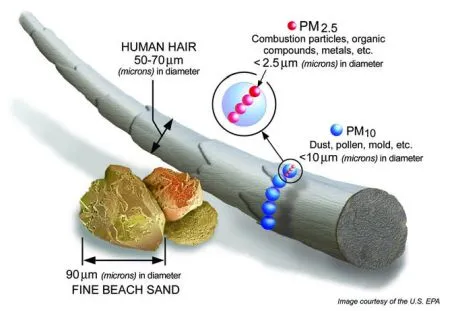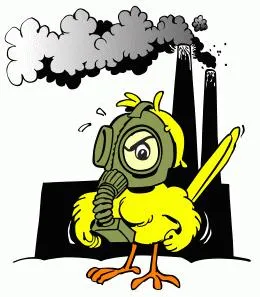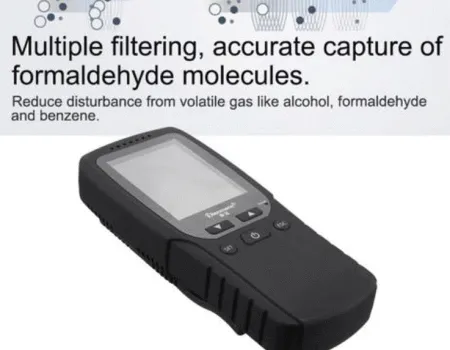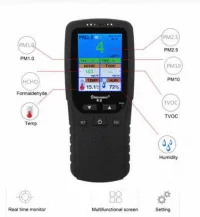Air Quality MeterNZ$167.61Approx USD$99.95
The Hidden Air Pollutants in Your Home According to the Environmental Protection Agency, the top five air quality problems in the U.S. are all indoor air problems. Common residential indoor pollutants include excessive moisture, volatile organic compounds (VOCs), combustion products, radon, pesticides, dust particles, viruses, and bacteria.
PM2.5 readings are often included in air quality reports from environmental authorities and companies. Find out what they mean and why you should monitor their levels.
PM2.5 refers to atmospheric particulate matter (PM) that have a diameter of less than 2.5 micrometers, which is about 3% the diameter of a human hair.
Fine particles can come from various sources. They include power plants, motor vehicles, airplanes, residential wood burning, forest fires, agricultural burning, volcanic eruptions and dust storms. Some are emitted directly into the air, while others are formed when gases and particles interact with one another in the atmosphere.
Why Are PM2.5 Dangerous
Innocent Studies have found a close link between exposure to fine particles and premature death from heart and lung disease. Fine particles are also known to trigger or worsen chronic disease such as asthma, heart attack, bronchitis and other respiratory problems.
A study published in the Journal of the American Medical Association suggests that long-term exposure to PM2.5 may lead to plaque deposits in arteries, causing vascular inflammation and a hardening of the arteries which can eventually lead to heart attack and stroke. Scientists in the study estimated that for every 10 micrograms per cubic meter (µg/m3) increase in fine particulate air pollution, there is an associated 4%, 6% and 8% increased risk of all-cause, cardiopulmonary and lung cancer mortality, respectively. Source
PM 1 The smaller the SIZE of the particulate,
the greater the toxicity. Very small particulate
(diameter less than 2.5 micrometer) is the most toxic
for human being, because:
PM 10 The growing awareness of PM10 is largely associated with the potential damaging effects they can have on the human body. The World Health Organisation (WHO) believes particles are affecting more people worldwide than any other pollutant. Primary health effects include damage to the respiratory and cardiovascular systems. Due to the small size of PM10 particles, they can penetrate the deepest parts of the lungs as well as access the gas exchange regions of the lung via diffusion.
"Formaldehyde (HCHO) is the most important carcinogen in outdoor air among the 187 hazardous air pollutants (HAPs). Colorless, poisonous, highly water-soluble gas with an obnoxious odor. Used in the manufacture of disinfectants, preservatives, and hundreds of industrial and consumer products such as adhesives, carpeting, decorative paneling, foam insulation, drapery, fiber and particle boards, and permanent press fabrics. Formaldehyde is a prominent factor in sick-building syndrome (SBS) as its emissions (accelerated by heat and moisture) irritate eyes and mucous membranes in nose and throat, and cause headache and dizziness. Officially named as methanal (not to be confused with methanol), it is classified as a possible carcinogen by EPA."
TVOC What are TVOCs? TVOCs stands for Total Volatile Organic
Compounds, which are the total amount of any emitted gases
with short or long-term health effects.
In Some countries your local weather forecast say that tomorrow will be a "code orange" day for air pollution? That's the Air Quality Index at work. The Air Quality Index, or AQI, is the system used to warn the public when air pollution is dangerous. The AQI tracks ozone (smog) and particle pollution (tiny particles from ash, power plants and factories, vehicle exhaust, soil dust, pollen, and other pollution), as well as four other widespread air pollutants. Newspapers, radio, television, and websites report AQI levels year-round. Keeping track of the current air quality information can help you take steps to protect yourself, children, and others from unhealthy levels of air pollution.
Air Quality Meter
|
Your IP Address is: 3.149.0.128
Copyright © 2025 Altered States. Powered by Zen Cart










.webp)







